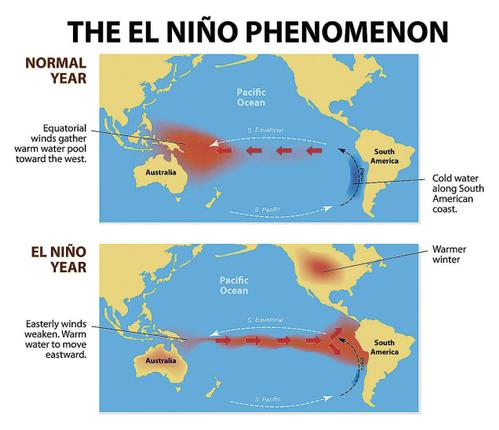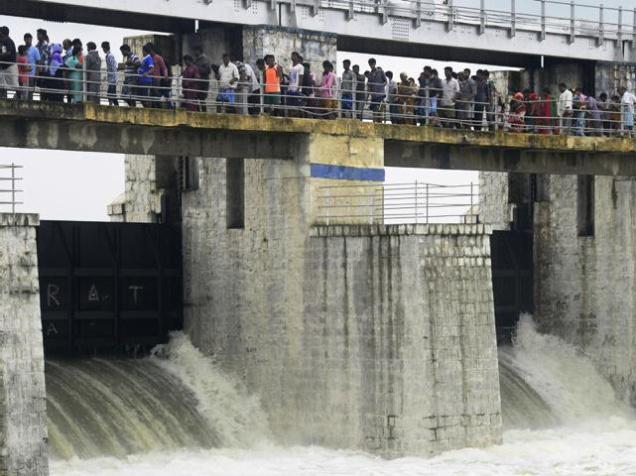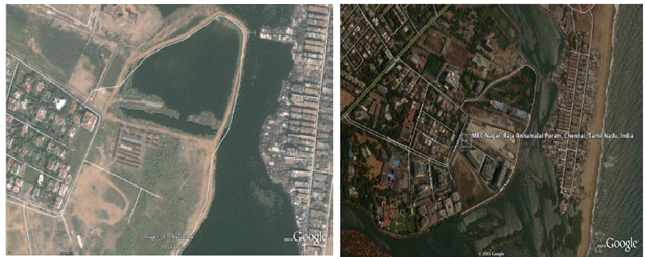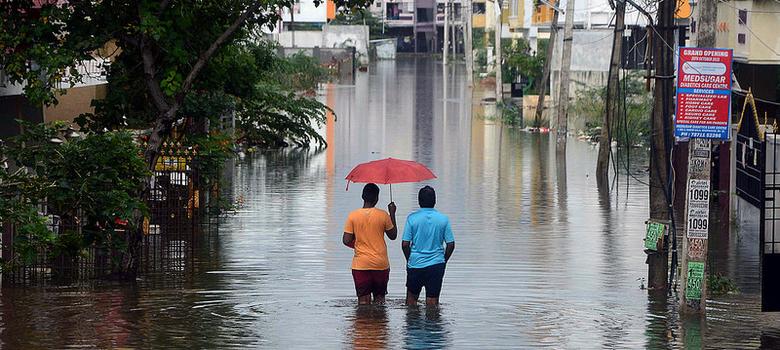
The Monsoon that has a huge influence on the Economy of India is directly linked to ENSO due to which, in summer months, temperatures over much of India may rise while the Indian Ocean will remain cooler. Consequently, the warm air over the land rises and the cooler moisture bearing air blows in from the sea bringing heavy rains to the region. The heavy rains that we have to concern ourselves with here is due to this complex phenomenon of El Nino and its impact on the North East Monsoon that hits the region between October and December. The Low Pressure winds that were caused by this phenomenon, which brought the rain moves slowly and thus the rain continued to pour down in Chennai.
Chennai is a city that has three main rivers – The Cooum, The Adyar, and the Kosasthalaiyar and the Chembarambaakam Lake. These 3 rivers flow in the Chennai Metropolitan Area and drain out into the sea and the Chembarabaakam lake is a rain-fed reservoir from which Chennai draws water . The Buckingham Canal is another important aspect to be considered. It is almost a 796 km long fresh water navigational canal that connects many natural backwaters along the coast to the port of Chennai.
When the rains began, the water in the reservoir exceeded the normal limits. To let water out of this reservoir, the express permission of the Chief Minister of Tamil Nadu is required and by the time the permission was granted, so much water had been accumulated. Thus instead of letting out the water in small quantities, the authorities had to release huge amounts of water all at once. The rivers already burdened with the heavy rainfall, couldn’t handle this immediate release of the water from the reservoir and began to overflow.

This is where the aspect of poor town planning comes into action. This was not the first time the city was facing the problem of the Adyar overflowing and the streets flooding. But that was when Chennai was referred to as just a overgrown village and not the huge developed Metropolitan city we know it to be. The Infrastructure that transformed Chennai came at a price. The brand new but flooded airport was constructed on the flood plain of Adyar, the Mass Rapid Transit system was constructed almost wholly over the Buckingham Canal and the Pallikaranai Marshlands, a IT corridor and a Knowledge corridor consisting of several Engineering and other colleges constructed on water bodies and SEZs and Gated Residential Areas built on important drainage and catchment areas, are some examples of poor town planning that really did play a role in increasing the magnitude of the impact of the flood. This encroachment into the Flood Lines of the water body and into the water body itself shows how much this is a Natural Disaster as well as partly a man made one. The corporation looks even more guilty when they did not take action even after the commission set up after the 2005 Floods informed of these massive encroachments.
The 2 Google World Images of the city of Chennai clearly establishes the said fact.

The Town Planning, was also deprived of an able administrator and competent civil personnel, when Dr Vijay Pingale was transferred just 3 days after he named contractors who botched up road work in the city and fined them in an unprecedented move to bring more transparency to the system in the city. His transfer is said, to be due to the influence of the powerful contract lobby of the city. Even with him there, the city would have probably suffered. for one man can’t modify and change the entire system in a matter of months.
However the city had developed mechanisms after the previous flood but with the degree of encroachment into the rivers and unexpected levels of rainfall due to El Nino, the system failed .When all the rivers overflowed at the same time, there was huge amounts of water to be drained out. The system that had been developed for this situation, and to take all this water out to the sea, could not handle these huge amounts. This is because of the fact that the system was designed to cope with 60-70 cm’s of rainfall but the rainfall that Chennai got was 110 cm and above, exceeding the limit by 50 cm’s. On top of the rivers overflowing the above mentioned Buckingham Canal also overflowed adding to a Chennaiiete’s misery.
The Effect of the Flood on the city was something, the city was completely unused to. The City got isolated, from the Rest of the World. The Airports did not function, the Railways stopped, the Highways were completely submerged, the telephone lines went down and the power was down. The City went Dark. To add to this, was the huge problem caused by the unscientific disposal of waste. The rivers and the canal that were used as waste dumps, by the people of the city, overflowed and flooded, the waste also came with it causing non-availability of drinking water was also a huge problem in certain localities. Water was all around them but not one drop of it was fit enough to be drunk. The poor suffered more as in most cases, especially those who lived in the slums, with no place to take shelter and survive. The rich too were affected, their basements filled up with water, their cars went down, mobiles got turned off and businesses stopped. In truth, the flood did not discriminate between the rich and the poor.
But the most important thing that the flood really showed us, was the people’s will to survive and help others survive. The People played a huge role in the relief work by rescuing those stranded in different places and giving them shelter. They came together and found ways to face Nature’s fury. The Relief was not only done out of Chennai but also away from Chennai. Chennaiites who were lucky enough to get out before the situation reached its extreme, tried to establish contact with those who were still back home. They made communication possible through their contacts and gave relief to the families of those who were stranded without any possible way to communicate. The marvelous thing to be noted is that when all other networks went down , the only mobile network that survived the onslaught was BSNL. The Army, as always, along with the Navy also played a huge role in minimizing the causalities. They went out to regions where the common people, could not go out to rescue the stranded and they coordinated the distribution of relief materials. NGO’s were another important aspect during the whole relief process. They purchased materials from regions where shops actually opened up and transported it to the ravaged regions. This however had some problems to it because when the NGO’s bought up everything in a region, the people in the region had to rely on some other sources. But this problem, was not one with any huge impact, as these regions could get the relief materials dispatched quite easily.
Recent reports suggests that, the city is recovering well. The city, I am sure like most of us that, it will come back and will be a greater force, that won’t succumb to the rain, atleast not in this large magnitude.

